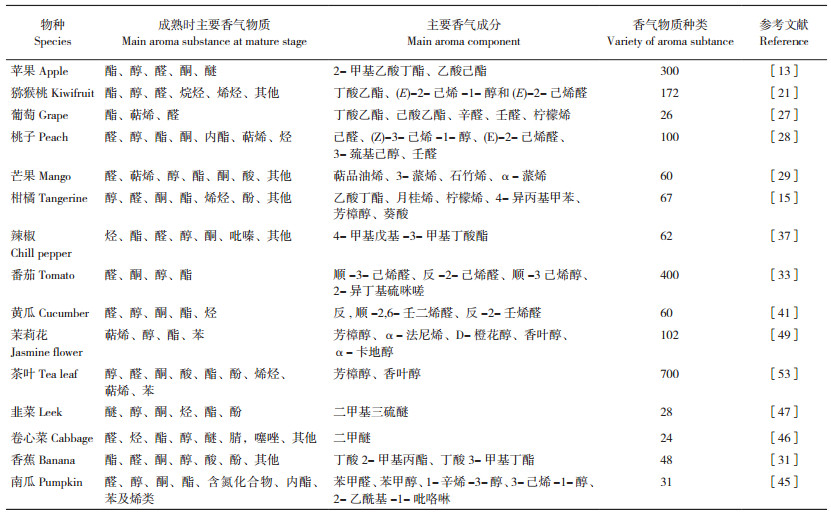文章信息
基金项目
- 2022年广东省乡村振兴战略专项资金种业振兴项目(2022-NJS-00-005);贵州省毕节市科学技术揭榜挂帅项目(毕科合重大专项〔2022〕3号);广东省教育厅重点学科建设基础研究重大项目(2021ZDJS004);国家自然科学基金(32072598)
作者简介
- 叶楚(1999—),女,在读硕士生,研究方向为辣椒品质育种及品质性状形成机理,E-mail:Lenorayip666@163.com.
通讯作者
- 衡周(1988—),男,博士,助理研究员,研究方向为辣椒品质育种及品质性状形成机理,E-mail:hengzhou@gdaas.cn.
文章历史
- 收稿日期:2023-09-28
2. 广东省农业科学院蔬菜研究所/广东省蔬菜新技术研究重点实验室,广东 广州 510640
2. Vegetable Research Institute, Guangdong Academy of Agricultural Sciences/Guangdong Key Laboratory of New Technology Research of Vegetables, Guangzhou 510640, China
香气由植物细胞中的挥发性有机物(Volatile organic compounds,VOCs)产生,主要包括酯类、醇类、醛类、酮类、醚类、萜类、烷烃、苯等物质。VOCs能赋予园艺作物独特风味[1]。园艺作物包括果树、蔬菜、花卉、茶叶4大类。在花卉中,挥发物是具有生物学和经济意义的植物源物质,也是植物抵御病虫害和食草动物的一种自我保护机制,更是吸引传粉昆虫和种子传播者进行繁衍的手段[2]。花香、茶叶香挥发物低分子量和亲脂性的特点源自生物合成途径,包括萜类化合物、苯丙类化合物/苯类化合物和脂肪酸[3-4],其中挥发性萜类化合物是最丰富的挥发性有机化合物之一,其次是选择性苯环/苯丙烷。果树和蔬菜会产生多种挥发性化合物,是其独特香气和风味的来源,常见的挥发性化合物有酯、醛、醇、内酯、酮、萜类化合物等,它们决定了香气的差异[5]。果树、蔬菜的挥发性化合物源于生物合成途径,包括脂氧合酶(Lipoxygenase, LOX)途径、β-氧化途径在内的脂肪酸途径以及由支链氨基酸产生支链酯的氨基酸途径。
园艺作物是农业生产的一部分,相比于其他作物,具有规模小、集中种植和经济价值高的特点。在目前产量基本满足市场需求的情况下,品质成为了提升园艺产品经济价值的突破口。香气物质能丰富园艺产品的味觉层次,是品质研究的重要方向。但是,市面上很多园艺作物的香气出现减弱现象,一些缺乏风味的番茄甚至被消费者称为“水弹”[6],因此,针对园艺作物香气合成机理的研究及相关品种的选育是育种市场和消费市场的迫切需求。
随着香气物质检测技术和分子生物学技术的发展,特别是气相色谱-质谱联用技术(Gas chromatography-mass spectrometry,GC-MS)等分析技术的广泛应用,园艺作物的主要香气活性物质及其合成途径和调控机理方面的研究也取得了较大进展[7-9]。然而,对于园艺作物香气的相关酶的生理功能、香气的遗传控制及其影响因素等方面的研究有待进一步挖掘。本文结合前人研究,综述了不同园艺作物的香气物质成分、影响园艺作物香气形成因素、园艺作物挥发性香气化合物的生物合成途径及调控,以期为研究者、生产者鉴别优秀种质资源,为培育品质优良、香气浓厚、商品价值可观的园艺作物提供参考。
1 园艺作物香气物质成分园艺作物在成熟过程中会产生不同类型的VOCs,它们赋予植物丰富的香气,是园艺产品的重要感官特征。不同园艺作物香气的物质和种类各不相同(表 1)。
1.1 果树果实香气成分
1.1.1 仁果类 仁果类果树中,苹果和梨的香气物质有较多的报道。目前苹果中已经鉴定到300多种VOCs,仅有少数是影响感官评价的香气活性物质[10]。不同品种的香气活性物质不同,‘蜜脆’苹果的果皮和果肉共有物质为丁酸乙酯、2-甲基丁酸乙酯和己酸乙酯等9种酯类物质[12];‘欧林’苹果的果香成分则主要是丁酸乙酯、丙酸己酯、乙酸己酯和乙酸丁酯[13];‘富士’苹果果实的香气分析研究表明2-甲基乙酸丁酯和乙酸己酯是其主要VOCs,苹果生长的年平均温度在一定范围内与香气物质含量显著相关[14]。
在新鲜梨果实中已有300多种VOCs被鉴定。例如,对12种西洋梨香气物质分析发现,酯和醇是梨果实香气的主要香气活性物质,包括乙酸3-(甲硫基)丙酯、乙酸丁酯、乙酸庚酯、乙酸己酯、乙酸戊酯及3-壬醇[15];对中国的香绵梨和木头素梨分析发现,2-甲基丁酸乙酯和己酸乙酯是其果香的主要贡献来源[16]。
1.1.2 柑果类 柑橘香气包括两部分,一部分是柑橘自然状态下所产生的香气,另一部分则是由于果皮受极端环境条件导致结合态物质水解释放出来造成的香气[17]。对我国5种柑橘的香气物质分析,表明乙酸丁酯、月桂烯、柠檬烯、4-异丙基甲苯、芳樟醇和葵酸是其重要的香气贡献者[18],其中月桂烯、柠檬烯等物质以结合态的形式存在于果皮中,自然条件下对果实的香气没有贡献,只有在受到机械损伤、过热、过酸和过碱等极端情况下产生特异刺激性气味[19]。对6种柑橘结合态和游离态香气物质比较分析,发现游离态香气物质浓度远大于结合态香气物质,而且结合态香气物质种类与游离态的也大不相同,不同品种间的差异也很大[20];柑橘皮中的结合态香气物质则相反,柠檬烯、月桂烯等结合态香气物质占果皮中香气物质的大部分[21]。柑橘结合态的香气物质或许可以作为柑橘潜在香气物质,达到增强果实香气的目的[22]。
1.1.3 浆果类 浆果类果实香气以猕猴桃、葡萄的研究较多。我国市场常见23个品种猕猴桃中检测出172种香气物质,其中丁酸乙酯、(E)-2-己烯-1-醇和(E)-2-己烯醛是猕猴桃果实的核心香气成分[22]。对‘Hayward’和‘Hort16A’这2个品种猕猴桃结合态VOCs分析发现,猕猴桃中结合态VOCs不是猕猴桃香气的潜在来源,甚至是异味来源,其中‘Hort16A’的花香味来自1, 8-桉树醇,这主要归因于其特有的基因型[23-24]。对17个猕猴桃种质香气物质分析,发现其中的VOCs与矿物质的含量相关[25]。
对多种葡萄香气分析表明,酯是酯香型葡萄中含量最丰富的VOCs,其中乙酸乙酯占总酯含量90%以上。挥发性C6化合物构成了葡萄果实的香气背景,果香程度则取决于酯类和萜烯类,如丁酸乙酯、己酸乙酯、辛醛、壬醛、柠檬烯等。葡萄中酯类香气物质主要存在于果肉,其他香气物质存在于果皮中,尤其是萜烯类物质[26]。
1.1.4 其他果树 桃果实中已鉴定到100多种VOCs,其中己醛、(Z)-3-己烯-1-醇、(E)-2-己烯醛、3-巯基己醇、壬醛、γ-壬内酯和γ-癸内酯对桃的香气贡献很大[27]。对25种芒果香气物质分析鉴定,发现萜品油烯、3-蒎烯、石竹烯、α-蒎烯对其香气贡献很大[28],而在刘传和等[29]对4种芒果香气的研究中发现3-长松针烯的相对含量最高。香蕉中已鉴定到250多种VOCs[30],其中丁酸2-甲基丙酯和丁酸3-甲基丁酯被认为是香蕉果实香气的主要成分[31]。
1.2 蔬菜香气成分1.2.1 茄果类 番茄和辣椒作为重要的园艺经济作物,其香气是重要商品性状之一。番茄在成熟过程中形成的VOCs决定番茄的风味[32],目前已经在成熟番茄中分析鉴定出400多种VOCs[33]。番茄果实在不同发育阶段香气成分及含量有较大的差异,例如‘金棚一号’番茄果实中C6醛在绿熟期相对含量较高,随后下降;‘牦牛儿’番茄丙酮含量随着果实发育成熟而升高,在完熟期达到最高[34]。对成熟樱桃番茄分析鉴定,发现顺-3-己烯醛和反-2-己烯醛性质活跃,分别有强烈的绿草味和绿叶味[35]。新鲜番茄最具代表性的香气化合物为顺-3己烯醇和2-异丁基硫咪嗟,乙醛和β-紫罗兰酮则与番茄酸味相关[36]。
挥发性酯类是辣椒果实中最重要的香气成分[37],如中国辣椒(Capsicum chinese)品种的果香香气是吸引消费者购买的重要品质性状[38]。‘JT-1’辣椒果实VOCs主要是4-甲基戊基-3-甲基丁酸酯,属于挥发性酯类,其含量在果实发育第3周开始增长[39]。在‘哈瓦那’辣椒提取的挥发物分析得到6-甲基-(E)-4-庚烯基-3-甲基丁酸酯,是主要VOCs之一[40]。不同发育阶段辣椒果实的香气具有显著差异,果实发育初期产生的香气物质以醛类为主,果实发育中后期产生的香气物质以酯类为主[37-39]。
1.2.2 瓜类 瓜类蔬菜中,有关黄瓜、南瓜香气的研究较多。目前黄瓜中鉴定出78种主要芳香物质[41],果实香气成分及含量受到不同发育时期、不同基因型及栽培环境的影响。刘春香等[42]研究不同发育时期的黄瓜,发现果实发育到12 d时反, 顺-2, 6-壬二烯醛和反-2-壬烯醛含量达到最高;在11种不同基因型的黄瓜果实鉴定出壬醛、戊醛、(E, Z)-3, 6-壬二烯-1-醇、樟醛、2-戊基-呋喃、1-己醇分别归不同基因型黄瓜所有[43];‘威盛1号’砧木嫁接提高了黄瓜果实中总酯类、醇类、醛类、烯类物质含量,而黑籽南瓜嫁接的黄瓜果实的挥发物含量出现降低现象[44]。李俊星等[45]研究南瓜芋香味VOCs成分,发现2-乙酰-1-吡咯啉(2-AP)为南瓜芋香味主要贡献物质。
1.2.3 叶菜类 叶菜类蔬菜中,目前对卷心菜、西兰花和韭菜的香气物质研究的较多。从卷心菜中鉴定并定量出24种挥发物,其中硫氰酸盐/异硫氰酸盐和醚VOCs是卷心菜刺激性气味主要贡献者[46];中国韭菜中共鉴定到28种VOCs,其中醚和醛是主要VOCs[47]。不同颜色的甘蓝品种对VOCs含量影响有差异,其中紫甘蓝的VOCs(壬醛、(E)-2-己烯醛和乙酸乙酯等)含量普遍比青甘蓝高[46]。另外,不同组织处理对其挥发物含量有所影响,西兰花头部经过硒处理后其挥发物含量有所增加,其中醛、酯和醇占大多数[48]。
1.3 花卉香气成分近年来在花卉香气物质的研究中,茉莉花[Jasminum sambac (Linnaeus) Aiton]占比较高。茉莉花是木犀科茉莉属植物,通常在夜间开花释放香气。目前共鉴定出102种挥发物,主要物质是萜烯类、醇类、酯类等[49],其中芳樟醇、α-法尼烯、D-橙花醇、香叶醇、α-卡地醇等16种挥发物是典型茉莉花关键香气物质[50]。不同品种的茉莉花、同一品种不同花色期的茉莉花、花开放程度的香气成分/含量有明显差异。例如,单瓣茉莉花的香气成分含量比双瓣及多瓣茉莉花更高,通常是生产加工的首选[51];鸳鸯茉莉紫花期与白花期VOCs中萜烯类与醇类物质的相似性较低[49];茉莉花香气成分含量与花开放程度呈正比,在开放期的香气成分含量最高,萜类和酯类是其主要香气物质[52]。
1.4 茶叶香气成分目前从茶叶中提取并分离出以醇、醛、酮、酸、酯、酚类为主的700多种化合物[53]。茶叶根据加工方式分为绿茶、红茶、乌龙茶、白茶、黑茶和黄茶6大类,它们的关键香气挥发物成分各有不同[54]。绿茶主要有花香型和清香型,由同一品种绿茶分别加工成不同的香型,其中花香型酯类物质含量较高,而清香型的醇类、烯烃类物质含量较高[55];红茶的花香型和甜香型VOCs成分有反式-芳樟醇氧化物、芳樟醇、香叶醇等醇类物质[56-57];乌龙茶以橙花叔醇、α-法尼烯、香叶醇为主的醇类、烯烃类为关键香气成分[58];黑茶香气特征中陈香与1, 2, 3-三甲氧基苯及1, 2, 4-三甲氧基苯等烷氧基苯类化合物有关,菌花香与烯醛类化合物有关[59]。
2 影响园艺作物香气形成的因素园艺作物果实香气主要受基因表达、栽培条件、采后处理等因素的影响。通过分子水平研究园艺作物的物种差异、栽培条件、基因表达等因素,不仅可揭示园艺作物香气产生的机理,还有利于育成香气淳厚、商品价值高的园艺作物新品种。
2.1 基因表达苹果中发现MdLOX、MdAAT2和MdADH3参与果实香气物质的生成[60],而MdArAT、MdACPD、MdADH3、MdAAT2和MdLOX表达的变化可能是导致不同苹果品种间VOCs有差异的原因[61]。番木瓜中发现CpLIS1可能负责芳樟醇的生物合成,CpAAT1和CpACX1可能负责在果实成熟过程中合成酯或内酯[62]。草莓6个FaAP2候选基因中有4个WRI同源物和2个AP2同源物,通过表达谱鉴定,其可能是红色水果颜色或特殊水果香气的调节剂[63]。在梨中发现,LOX通路相关基因PuLOX3、PuADH3和PuAAT的表达对‘南果’梨总酯和主酯变化的贡献最大[64]。薄皮甜瓜中发现CmLOX12、CmLOX03、CmLOX18和CmLOX16这4个基因可能是酯类香气合成过程中的主要基因[65]。
2.2 栽培条件栽培条件是影响园艺作物果实香气物质的重要因素。研究发现,不同套袋的葡萄产生的香气物质有所差异,转录水平上的分析表明这种差异可能是光响应因子VvAAT不同表达而造成的[66]。这种情况在猕猴桃[67]、黄桃[68]、梨[69]、苹果[70]等水果中也有出现。
在土壤栽培条件下,草莓香气物质种类和含量明显高于基质栽培[71],包括FaQR、FaOMT、FaNES1、FaSAAT和FaAAT2这些与挥发性生物合成相关的转录物。通过对不同施肥条件下草莓[72]的香气物质分析也发现了类似结果。另外,有研究发现,喷施含硒肥料对番茄香气表现出明显积极作用[73]。
2.3 采后处理贮藏温度和乙烯含量都是影响果实采后香气物质的因素,通过低温和控制乙烯浓度可以延缓果实的成熟,进而影响园艺作物的香气[74-75]。对热带水果山竹进行低温处理,发现山竹的成熟过程延缓,但其芳香物质含量也受到了抑制,原因是香气前体物质β-丙氨酸、异亮氨酸、缬氨酸、丙氨酸的合成受到了抑制[76],在酥瓜[77]中也得到了类似结果。梨采收前2~3 d喷施4% CaCl2可以防止长期冷藏过程中香气减弱,而室温下喷施4% CaCl2的梨则表现出比不喷施的呼吸效率更高、乙烯和脂肪酸产量更高的现象。研究表明,经CaCl2处理的果实中与LOX途径相关的脂氧合酶和氢过氧化物裂解酶(Hydroperoxide lyase,HPL)具有更高的基因表达[78],喷施茉莉酸甲酯(MeJA)也得到了相似的结果[79]。
乙烯可以加快果实成熟,生产上通常利用乙烯利来代替乙烯,从而加快果实成熟进程,1-甲基环丙烯(1-MCP)则作为乙烯受体抑制剂用作果实的保鲜剂。利用乙烯利以及1-MCP分别处理梨,发现乙烯利处理过的梨会提前出现呼吸高峰,成熟衰老进程加快;而1-MCP处理的梨则呼吸高峰延迟,成熟过程减慢,并且保持醇类的多样性,但抑制了醇类含量的增加[80]。有研究发现,先利用1-MCP处理草莓能延长其保鲜期,再利用二氧化氯(ClO2)处理可恢复草莓的VOCs[81]。用1-MCP处理蓝莓也能明显延长蓝莓的的保鲜期,但是蓝莓香气物质也受到了抑制;同时使用乙烯和1-MCP处理不仅对蓝莓果实起到保鲜作用,且香气物质比刚采摘时无明显减少[82]。
3 园艺作物香气物质的生物合成途径园艺作物果实香气物质主要由脂肪酸途径、氨基酸途径、莽草酸/苯丙素途径、萜类途径产生(图 1)。其中脂肪酸途径又分为脂氧合酶途径和β-氧化途径,萜类途径可分为甲羟基戊酸(MVA)和2-甲基赤藓糖-4-磷酸(MEP)途径。果实中的直链醛、醇、酯主要通过植物的脂氧合途径以及β-氧化途径产生,支链醛、醇、酯由氨基酸途径产生,萜类化合物由萜类途径产生,多酚类化合物由莽草酸/苯丙素途径产生。
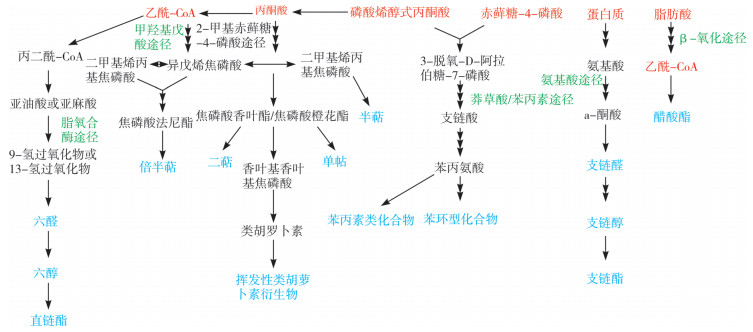
|
| 图中红色字体代表合成前体物质或初生代谢物,绿色字体代表合成途径,蓝色字体代表VOCs,箭头表示合成方向(多重箭头表示有多个反应参与) The red fonts represent the synthetic precursor materials or primary metabolites, the green fonts represent the synthetic pathways, the blue fonts represent the volatile aroma compounds, and the arrow indicates the direction of synthesis (multiple arrows indicate the participation of multiple reactions) 图 1 植物果实香气物质生物合成途径[83-85] Fig. 1 Aroma substance biosynthesis pathway of plant fruit[83-85] |
3.1 脂肪酸途径
脂肪酸途径主要由脂氧合酶途径和β-氧化途径组成。脂氧合酶途径主要在细胞质中发生,β-氧化途径主要在线粒体中发生,前者多发生在受机械损伤果实,后者较多发生在完整果实的生长过程[86]。
3.1.1 脂氧合酶途径 植物体中经脂氧合酶催化氧化多不饱和脂肪酸(PUFAs)形成的代谢产物称为氧化脂类,包括氧脂素形成过程在内的代谢途径统称为脂氧合酶途径[87]。果实中的醛[27-28]来自脂肪酸代谢,在醇脱氢酶(ADH)的作用下,醛类还原成相应的醇类;醇类则作为酯类物质的直接前体,其在醇酰基转移酶(AAT)的作用下形成酯(图 2)。
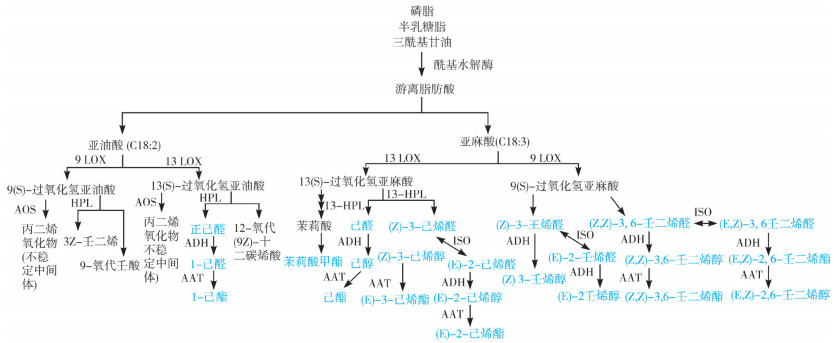
|
| 蓝色字体表示香气物质,LOX:脂肪氧化酶,HPL:氢过氧化物裂解酶,ADH:醇脱氢酶,ISO:异构酶,AOS:丙二烯氧化合酶,AAT:醇酰基转移酶 Blue fonts indicate aroma substances, LOX: Fat oxidase, HPL: Hydroperoxide lyase, ADH: Alcohol dehydrogenase, ISO: Isomerase, AOS: Allene oxide synthase, AAT: Alcohol acyl transferase 图 2 脂氧合酶途径[88-89] Fig. 2 Lipoxygenase pathway[88-89] |
3.1.2 β-氧化途径 脂肪酸的β-氧化是为酯形成提供醇和酰基辅酶A(CoAs)的主要生物合成过程[90]。虽然直链脂肪酸通过β-氧化的降解是园艺作物风味分子形成的主要过程,但其具体途径尚不清楚[30]。仁果类果实(如苹果、梨)[8]的酯通过β-氧化途径形成,酰基辅酶A被还原成醛,醛又被醇脱氢酶(ADH)还原为醇,再被醇酰基转移酶(AAT)生成酯(图 3)。
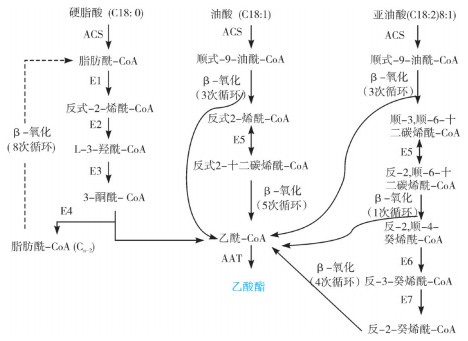
|
| 蓝色字体表示香气物质,ACS:酰基-CoA合成酶,E1:酰基-CoA氧化酶,E2:反式-2-烯酰基-CoA水合酶,E3:l-3-羟酰基-CoA脱氢酶,E4:3-酮硫解酶,E5:∆3, ∆2-烯酰基-CoA异构酶,E6:2, 4-二烯酰基-CoA还原酶,E7:烯酰基-CoA异构酶 Blue font indicates aroma substance, ACS: acyl-CoA synthase, E1: acyl-CoA oxidase, E2: trans-2-enyl-CoA hydrase, E3: l-3-hydroxyyl-CoA dehydrogenase, E4: 3-ketothiolase, E5: 3, 2-enyl-CoA isomerase, E6: 2, 4-dienyl-CoA reductase, E7: enyl-CoA isomerase 图 3 β-氧化途径[91-92] Fig. 3 β–oxidation pathway[91-92] |
3.2 氨基酸途径
通过支链氨基酸异亮氨酸(Ile)、亮氨酸(Leu)和缬氨酸(Val)产生支链酯的途径是氨基酸途径。香蕉[93]、苹果[94]、草莓[95]、辣椒[96]果实中的支链挥发性醇、醛和酯源自支链氨基酸代谢,在支链α-酮酸脱羧酶(BCKDC)作用下,支链醛还原成相应的支链醇。醇类则作为酯类物质的直接前体,其在醇酰基转移酶(AAT)的作用下形成支链酯(图 4)[97-98]。

|
| 蓝色字体表示香气物质;AAT:醇酰基-CoA转移酶;ADH:乙醇脱氢酶;BCAT:支链氨基转移酶;BCKDC:支链α-酮酸脱羧酶;BCKDH:支链α-酮酸脱氢酶 The blue fonts indicate aroma substances; AAT : Alcohol acyl-CoA transferase; ADH : Alcohol dehydrogenase; BCAT : Branched chain aminotransferase; BCKDC : Branched α-ketoacid decarboxylase; BCKDH : Branched α-ketoacid dehydrogenase 图 4 支链氨基酸代谢[97-98] Fig. 4 Branched chain amino acid metabolism[97-98] |
3.3 莽草酸/苯丙素途径
植物通过莽草酸/苯丙素产生含苯的VOCs的途径称为苯草酸途径。果实、花卉、茶叶中的挥发性苯源于莽草酸代谢,以赤藓糖-4-磷酸(D-erythrose 4-phosphate,E4P)为前体催化反应转变成分支酸,分支酸反应生成苯丙氨酸,最后苯丙氨酸生成各种含苯的VOCs(图 5)[99-101]。
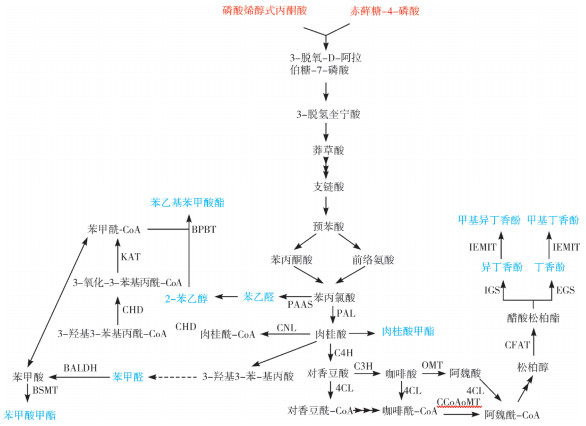
|
| 实线箭头表示已建立的生化步骤,而尚未描述的假设步骤由虚线箭头表示;堆叠箭头说明多个酶促反应参与;红色字体表示前体物质,挥发性苯/苯丙烷化合物以蓝色字体突出显示。BALDH:苯甲醛脱氢酶;BPBT:苯甲酰辅酶A苄醇/2-苯基乙醇苯甲酰转移酶;BSMT:苯甲酸/水杨酸羧基甲基转移酶;CFAT:松柏醇乙酰转移酶;C3H:对香豆酸-3-羟化酶;C4H:肉桂酸-4-羟化酶;CCoAOMT:咖啡酰-CoA 3-O-甲基转移酶;4CL:4-香豆酰辅酶A连接酶;CNL:肉桂酰辅酶A连接酶;EGS:丁香酚合酶;IEMT:(异)丁香酚O-甲基转移酶;IGS:异丁香酚合酶;KAT:3-酮酰基辅酶A硫解酶;OMT:O-甲基转移酶;PAAS:苯乙醛合酶;PAL:苯丙氨酸解氨酶 Solid arrows indicate established biochemical steps, while hypothetical steps not described are indicated by dashed arrows. Stacked arrows illustrate the involvement of multiple enzymatic reactions. Red font indicates precursor material and volatile benzene/phenylpropane compounds are highlighted in blue fonts. BALDH: Benzaldehyde dehydrogenase; BPBT: Benzoyl-CoA: benzyl alcohol/2-phenyl ethanol benzoyl transferase; BSMT: Benzoic acid/salicylic acid carboxyl methyltransferase; CFAT: Coniferyl alcohol acetyltransferase; C3H: p-coumarate-3-hydroxylase; C4H: Cassia bark acid-4-hydroxylase; CCoAOMT: Caffeoyl-CoA 3-O-methyltransferase; 4CL: 4-Coumartol-CoA ligase; CNL: Cassia bark acyl-CoA ligase; EGS: Eugenol synthase; IEMT: (I) Eugenol O-methyltransferase; IGS: Isoeugenol synthase; KAT: 3-ketoacyl-Coenzyme A thiolase; OMT: O-methyltransferase; PAAS: Phenylacetaldehyde synthase; PAL: Phenylalanine ammonia lyase 图 5 莽草酸/苯丙素途径[58, 99-101] Fig. 5 Shikimic/phenylpropanoid pathway[58, 99-101] |
3.4 萜类途径
萜类化合物在高等植物中是通过两种平行途径合成的,花卉、茶叶的萜烯成分源于萜类代谢(图 6)[59, 102]:甲羟戊酸(MVA)途径,以两个乙酰CoA的缩合开始,反应部位为细胞质,形成不规则萜烯、倍半萜和三萜;甲基赤藓糖醇磷酸(MEP)途径,在质体中进行反应,以丙酮酸和3-磷酸甘油醛作为前体,形成挥发性胡萝卜素衍生物、单萜、二萜和四萜。
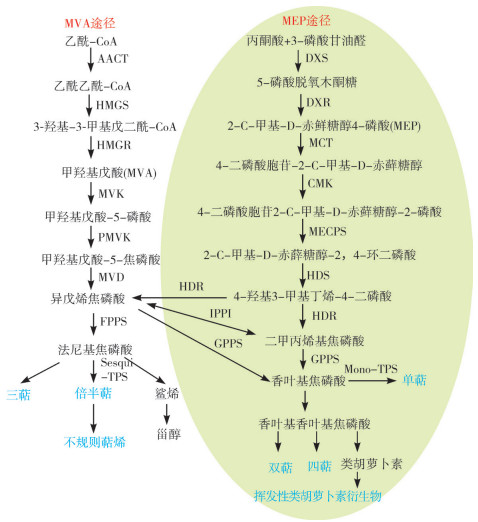
|
| VOCs用蓝色字体表示,其中AACT:乙酰乙酰辅酶A硫解酶;CMK:4-二磷酸胞苷-2C-甲基-D-赤藓糖醇激酶;DXR:1-脱氧-D-木酮糖-5-磷酸还原异构酶;DXS:1-脱氧-dxylulose-5-磷酸合酶;FPPS:法呢基二磷酸合酶;GPPS:香叶基二磷酸合酶;HDR:1-羟基-2-甲基-2-€-丁烯基-4二磷酸还原酶;HDS:1-羟基-2-甲基-2-€-丁烯基-4-二磷酸合酶;HMGR:3-羟基-3-甲基戊二酰辅酶A还原酶;HMGS:3-羟基-3-甲基戊二酰辅酶A合酶;IPPI:异戊烯二磷酸异构酶;MCT:4-二磷酸胞苷-2C甲基-D-赤藓糖醇合酶;MECPS=2C-甲基-D-赤藓糖醇4-磷酸胞苷转移酶;Mono-TPS:单萜合酶。MVD:甲羟戊酸二磷酸脱羧酶;MVK:甲羟戊酸激酶;PMVK:磷酸甲羟戊酸激酶;Sesqui-TPS:倍半萜合酶 Volatiles are indicated in blue fonts, AACT: Acetylacetyl-Coenzyme A thiolase; CMK: 4-cytidine diphosphate-2C-methyl-D-erythritol kinase; DXR: 1-deoxyl-D-xylose-5-phosphate reductomerase; DXS: 1-deoxygenation-dxylulose-5-phosphate synthase; FPPS: Normal-base diphosphate synthase; GPPS: geranyl diphosphate synthase; HDR: 1-hydroxyl-2-methyl-2-€-butenyl-4 diphosphate reductase; HDS: 1-hydroxyl-2-methyl-2-€-butyl-butyl-4-diphosphate synthase; HMGR: 3-hydroxyl-3-methylglutaryl CoA reductase; HMGS: 3-hydroxy-3-methylglutaryl-Coenzyme A synthase; IPPI: Isopentenyl diphosphate isomerase; MCT: 4-cytidine diphosphate-2C methyl-D-erythritol synthase; MECPS: 2 C-methyl-D-erythritol 4-cytidine phosphate transferase; Mono-TPS: Monoterpene synthase. MVD: Mevalonate diphosphate decarboxylase; MVK: Mevalonate kinase; PMVK: Mevalonate kinase; Sesqui-TPS: Sesquiterpene synthase 图 6 萜类途径(MVA和MEP)途径[59, 102] Fig. 6 Terpenoid pathway (MVA and MEP) pathway[59, 102] |
4 园艺作物香气相关酶的调控机理
目前关于园艺作物香气调控研究最多的是脂氧合酶基因。草莓脂肪酸合酶基因FaMYB9和FaMYB11会激活FaLOX5的启动子,使FaLOX表达水平上调,进而提高草莓水果味酯的含量达到增强草莓香气的目的[103-104]。番茄SlMYB75-OE基因不仅大幅提高番茄红熟期的花青素含量,而且还会激活TPS、LOXC和AADC2酶的启动子,使相关基因表达量升高,增加了番茄果实中醛、苯丙烷和萜烯类香气物质含量[105];番茄AtMYB12基因则通过激活初级代谢酶基因启动子,提高了相关酶活性,使得香气合成相关前体物质苯丙氨酸含量增加,进而提高果实香气[106]。苹果中乙烯响应因子MdERF1B与MdMADS24蛋白互作,形成的蛋白复合体与MdLOX1a启动子上的CArG-box结合,激活其转录活性,提高了MdLOX1a转录水平,直接促进香气物质合成[100],解释了乙烯影响苹果香气代谢的原因。而在柑橘中CitMYC3能通过激活乙烯信号传导末级原件基因CitAP2.10启动子和自我激活,共同调控合成瓦伦烯[107]。猕猴桃中丁酸乙酯和丁酸甲酯代谢调节网络一部分的AcNAC4直接调节猕猴桃中的AcAAT基因(AcAAT10),导致丁酸乙酯和丁酸甲酯的积累[108]。桃中通过点诱变影响PpAAT1在内部酯化和酯化反应中的酶活性[109]。
5 结语及展望香气是园艺作物品质重要的指标之一。园艺作物香气的生成过程十分复杂,受遗传特性、环境因子、栽培条件等众多因素的影响。近年来,人们对园艺作物香气的化学成分、合成途径及其影响因素进行了系统的研究,但对于园艺作物香气的相关酶的生理功能、香气的遗传控制及其影响因素等研究有待进一步挖掘。此外,香气物质与类黄酮代谢、糖代谢等其他代谢机制的联系的研究甚少。利用分子生物学技术和基因工程手段,通过克隆园艺作物香气合成关键基因,在分子水平上对园艺作物香气成分和含量进行精准调控,将是园艺作物香气研究的重要趋势。
| [1] |
NOBLE A C. Taste-aroma interactions[J]. Trends in Food Science & Technology, 1996, 7(12): 439-444. DOI:10.1016/S0924-244(96)10044-3 |
| [2] |
RAMASAMY K M, PALANISAMY M A, DEBANJAN D, ANIL D, KAILASH C S, SENGOTTAYAN S, PANKAJ K, PROBIR K G. The future of plant volatile organic compounds (pVOCs) research: Advances and applications for sustainable agriculture[J]. Environmental and Experimental Botany, 2022, 200: 104912. DOI:10.1016/j.envexpbot.2022.104912 |
| [3] |
DUDAREVA N, KLEMPIEN A, MUHLEMANN J K, KAPLAN I. Biosynthesis, function and metabolic engineering of plant volatile organic compounds[J]. New Phytologist, 2013, 198: 16-32. DOI:10.1111/nph.12145 |
| [4] |
NAGEGOWDA D A, GUPTA P. Advances in biosynthesis, regulation, and metabolic engineering of plant specialized terpenoids[J]. Plant Science, 2020, 294: 110457. DOI:10.1016/j.plantsci.2020.110457 |
| [5] |
OGUNDIWIN E A, PEACE C P, GRADZIEL T M, PARFITT D E, BLISS F A, CRISOSTO C H. A fruit quality gene map of Prunus[J]. BMC Genomics, 2009, 10: 587. DOI:10.1186/1471-2164-10-587 |
| [6] |
MAUL F, SARGENT S A, SIMS C A, BALDWIN E A, BALABAN M O, HUBER D J. Tomato flavor and aroma quality as affected by storage temperature[J]. Journal of Food Science, 2000, 65(7): 1228-1237. DOI:10.1111/j.1365-2621.2000.tb10270.x |
| [7] |
ABBAS F, ZHOU Y, O'NEILL R D, ALAM I, KE Y, WANG H C. Aroma components in horticultural crops: Chemical diversity and usage of metabolic engineering for industrial applications[J]. Plants (Basel), 2023, 12(9): 1748. DOI:10.3390/plants12091748 |
| [8] |
IZQUIERDO-CAAS P M, GONZÁLEZ V M A, MENA-MORALES A, PÉREZ N J, SÁNCHEZ-PALOMO E. Effect of fermentation temperature on volatile compounds of Petit Verdot red wines from the Spanish region of La Mancha (central-southeastern Spain)[J]. European Food Research and Technology, 2020, 246(6): 1153-1165. DOI:10.1007/s00217-020-03471-6 |
| [9] |
李秋棉, 罗均, 李雪萍, 陈维信. 果实香气物质的合成与代谢研究进展[J]. 广东农业科学, 2012, 39(19): 104-107. DOI:10.16768/j.issn.1004-874X.2012.19.061 LI Q M, LUO J, LI X P, CHEN W X. Progress in the synthesis and metabolism of fruit aroma substances[J]. Guangdong Agricultural Sciences, 2012, 39(19): 104-107. DOI:10.16768/j.issn.1004-874X.2012.19.061 |
| [10] |
ESPINO-DÍAZ M, SEPÚLVEDA D R, GONZÁLEZ-AGUILAR G, OLIVAS G I. Biochemistry of apple aroma: A review[J]. Food Technology Biotechnology, 2016, 54(4): 375-397. DOI:10.17113/ftb.54.04.16.4248 |
| [11] |
李瑞, 刘翠华, 石金瑞, 闫丹, 张琪, 刘潇然, 任小林. '蜜脆'苹果果皮和果肉香气差异[J]. 西北农业学报, 2019, 28(10): 1621-1631. DOI:10.7606/j.issn.1004-1389.2019.10.008 LI R, LIU C H, SHI J R, YAN D, ZHANG Q, LIU X R, REN X L. The aroma difference between the peel and pulp of the Cuimi apple[J]. Acta Agriculturae Boreali-occidentalis Sinica, 2019, 28(10): 1621-1631. DOI:10.7606/j.issn.1004-1389.2019.10.008 |
| [12] |
YANG S, MENG Z, LI Y, CHEN R, YANG Y, ZHAO Z. Evaluation of physiological characteristics, soluble sugars, organic acids and volatile compounds in 'Orin' apples (Malus domestica) at different ripening stages[J]. Molecules, 2021, 26(4): 807. DOI:10.3390/molecules26040807 |
| [13] |
QIN L, WEI Q P, KANG W H, ZHANG Q, SUN J, LIU S Z. Comparison of volatile compounds in 'Fuji' apples in the different regions in China[J]. Food Science and Technology Research, 2017, 23(1): 79-89. DOI:10.3136/fstr.23.79 |
| [14] |
CHEN Y, HAO Y, XIAO W, SHI X, QI K, ZHANG S. Comparative analysis of the volatile organic compounds in mature fruits of 12 Occidental pear (Pyrus communis L.) cultivars[J]. Scientia Horticulturae, 2018, 240: 239-248. DOI:10.1016/j.scienta.2018.06.014 |
| [15] |
YI X, LIU G, RANA M M, ZHU L W, JIANG S L, HUANG Y F, LU W M, WEI S. Volatile profiling of two pear genotypes with different potential for white pear aroma improvement[J]. Scientia Horticulturae, 2016, 209: 221-228. DOI:10.1016/j.scienta.2016.06.034 |
| [16] |
林雯雯, 楼舒婷, 孙玉敬, 叶兴乾. 柑橘汁中糖苷键合态香气物质的研究进展[J]. 食品工业科技, 2014, 35(17): 395-399. DOI:10.13386/j.issn1002-0306.2014.17.080 LIN W W, LOU S T, SUN Y J, YE X Q. Progress of glycosidic bonded aroma substances in citrus juice[J]. Food Industry Technology, 2014, 35(17): 395-399. DOI:10.13386/j.issn1002-0306.2014.17.080 |
| [17] |
SHUI M, FENG T, TONG Y, ZHUANG H, LO C, SUN H, CHEN L, SONG S. Characterization of key aroma compounds and construction of flavor base module of Chinese sweet oranges[J]. Molecules, 2019, 24(13): 2384. DOI:10.3390/molecules24132384 |
| [18] |
CHEN M H, HUANG T C. Volatile and nonvolatile constituents and antioxidant capacity of oleoresins in three Taiwan citrus varieties as determined by supercritical fluid extraction[J]. Molecules, 2016, 21(12): 1735. DOI:10.3390/molecules21121735 |
| [19] |
REN J N, TAI Y N, DONG M, SHAO J H, YANG S Z, PAN S Y, FAN G. Characterisation of free and bound volatile compounds from six different varieties of citrus fruits[J]. Food Chemistry, 2015, 185: 25-32. DOI:10.1016/j.foodchem.2015.03.142 |
| [20] |
ZHANG H, XIE Y, LIU C, CHEN S, HU S, XIE Z, DENG X, XU J. Comprehensive comparative analysis of volatile compounds in citrus fruits of different species[J]. Food Chemistry, 2017, 230: 316-326. DOI:10.1016/j.foodchem.2017.03.040 |
| [21] |
LIANG Z, FANG Z, PAI A, LUO J, GAN R, GAO Y, LU J, ZHANG P. Glycosidically bound aroma precursors in fruits: A comprehensive review[J]. Critical Reviews in Food Science and Nutrition, 2022, 62(1): 215-243. DOI:10.1080/10408398.2020.1813684 |
| [22] |
LAN T, GAO C, YUAN Q, WANG J, ZHANG H, SUN X, LEI Y, MA T. Analysis of the aroma chemical composition of commonly planted kiwifruit cultivars in China[J]. Foods, 2021, 10(7): 1645. DOI:10.3390/foods10071645 |
| [23] |
GARCIA C V, STEVENSON R J, ATKINSON R G, WINZ R A, QUEK S Y. Changes in the bound aroma profiles of 'Hayward' and 'Hort16A' kiwifruit (Actinidia spp.) during ripening and GC-olfactometry analysis[J]. Food Chemistry, 2013, 137(1-4): 45-54. DOI:10.1016/j.foodchem.2012.10.002 |
| [24] |
ZENG Y, WANG M Y, HUNTER D C, MATICH A J, MCATEE P A, KNÄBEL M, HAMIAUX C, POPOWSKI E A, JAEGER S R, NIEUWENHUIZEN N J, YAUK Y K, ATKINSON R G. Sensory-directed genetic and biochemical characterization of volatile terpene production in kiwifruit[J]. Plant Physiology, 2020, 183(1): 51-66. DOI:10.1104/pp.20.00186 |
| [25] |
ZHANG H, MO X, TANG D, MA Y, XIE Y, YANG H, SHI M, LI L, LI W, YAN F, ZHANG Y, ZHANG H, XU J. Comparative analysis of volatile and carotenoid metabolites and mineral elements in the flesh of 17 kiwifruit[J]. Journal of Food Science, 2021, 86(7): 3023-3032. DOI:10.1111/1750-3841.15796 |
| [26] |
WU Y, ZHANG W, DUAN S, SONG S, XU W, ZHANG C, BONDADA B, MA C, WANG S. In-depth aroma and sensory profiling of unfamiliar table-grape cultivars[J]. Molecules, 2018, 23(7): 1703. DOI:10.3390/molecules23071703 |
| [27] |
ZHU J C, XIAO Z B. Characterization of the key aroma compounds in peach by gas chromatography–olfactometry, quantitative measurements and sensory analysis[J]. European Food Research and Technology, 2019, 245: 129-141. DOI:10.1007/s00217-018-3145-x |
| [28] |
LI L, MA X W, ZHAN R L, WU H X, YAO Q S, XU W T, LUO C, ZHOU Y G, LIANG Q Z, WANG S B. Profiling of volatile fragrant components in a mini-core collection of mango germplasms from seven countries[J]. PLoS One, 2017, 12(12): e0187487. DOI:10.1371/journal.pone.0187487 |
| [29] |
刘传和, 刘岩. 4种芒果香气品质分析[J]. 广东农业科学, 2016, 43(10): 123-127. DOI:10.16768/j.issn.1004-874X.2016.10.022 LIU C H, LIU Y. Quality analysis of 4 mango aromas[J]. Guangdong Agricultural Sciences, 2016, 43(10): 123-127. DOI:10.16768/j.issn.1004-874X.2016.10.022 |
| [30] |
EL HADI M A, ZHANG F J, WU F F, ZHOU C H, TAO J. Advances in fruit aroma volatile research[J]. Molecules, 2013, 18(7): 8200-8029. DOI:10.3390/molecules18078200 |
| [31] |
PINO J A, FEBLES Y. Odour-active compounds in banana fruit cv. Giant Cavendish[J]. Food Chemistry, 2013, 141(2): 795-801. DOI:10.1016/j.foodchem.2013.03.064 |
| [32] |
张莉, 胡志峰, 邵景成, 耿新军. 番茄果实风味的组成及其影响因素研究综述[J]. 甘肃农业科技, 2020(12): 85-92. DOI:10.3969/j.issn.1001-1463.2020.12.020 ZHANG L, HU Z F, SHAO J C, GENG X J. Review of the composition and influencing factors of tomato fruit flavor[J]. Gansu Agricultural Science and Technology, 2020(12): 85-92. DOI:10.3969/j.issn.1001-1463.2020.12.020 |
| [33] |
BUTTERY R G, TAKEOKA G R. Some unusual minor volatile components of tomato[J]. Journal of Agriculure Food Chemistry, 2004, 52(20): 6264-6264. DOI:10.1021/jf040176a |
| [34] |
陈书霞, 林海军. 番茄果实不同发育阶段香气成分组成及变化[J]. 西北植物学报, 2010, 30(11): 2258-2264. CHEN S X, LIN H J. Composition and changes of aroma components in tomato fruit at different developmental stages[J]. Acta Botanica Boreali-Occidentalia Sinica, 2010, 30(11): 2258-2264. |
| [35] |
SELLI S, KELEBEK H, AYSELI M T, TOKBAS H. Characterization of the most aroma-active compounds in cherry tomato by application of the aroma extract dilution analysis[J]. Food Chemistry, 2014, 165: 540-546. DOI:10.1016/j.foodchem.2014.05.147 |
| [36] |
张静, 罗敏蓉, 王西芳, 胡晓辉, 赵静, 崔璐. 固相微萃取气质联用测定番茄香气成分条件优化[J]. 北方园艺, 2017(13): 7-13. DOI:10.11937/bfyy.20170199 ZHANG J, LUO M R, WANG X F, HU X H, ZHAO J, CUI L. Optimization of tomato aroma composition conditions[J]. Northern Horticulture, 2017(13): 7-13. DOI:10.11937/bfyy.20170199 |
| [37] |
HUANG C, SUN P, YU S, FU G, DENG Q, WANG Z, CHENG S. Analysis of volatile aroma components and regulatory genes in different kinds and development stages of pepper fruits based on non-targeted metabolome combined with transcriptome[J]. International Journal Molecule Science, 2023, 24(9): 7901. DOI:10.3390/ijms24097901 |
| [38] |
SOUSA E T, RODRIGUES F M, MARTINS C C, OLIVEIRA F S, P. PEREIRA A, ANDRADE J B. Multivariate optimization and HS-SPME/GC-MS analysis of VOCs in red, yellow and purple varieties of Capsicum chinense sp. peppers[J]. Microchemical Journal, 2006, 82(2): 142-149. DOI:10.1016/j.microc.2006.01.017 |
| [39] |
HENG Z, XU X, XU X M, WANG H M, LIU L, LI Z X, LI Z L, YOU Q, SUN B J, GONG C, YIN Y, LI Y, LI T. Characterization of odor-contributing volatile in Capsicum chinense 'JT-1' fruits during development and transcriptome analysis of key fruit-aroma formation periods[J]. Scientia Horticulturae, 2023, 309: 111691. DOI:10.1016/j.scienta.2022.111691 |
| [40] |
MURAKAMI Y, IWABUCHI H, OHBA Y, FUKAMI H. Analysis of volatile compounds from chili peppers and characterization of habanero (Capsicum chinense) volatiles[J]. Journal Oleo Science, 2019, 68(12): 1251-1260. DOI:10.5650/jos.ess19155 |
| [41] |
郝丽宁, 陈书霞, 刘拉平, 陈巧, 孟焕文, 王聪颖. 不同基因型黄瓜果实香气组成的主成分分析和聚类分析[J]. 西北农业学报, 2013, 22(5): 101-108. DOI:10.7606/j.issn.1004-1389.2013.05.017 HAO L N, CHEN S X, LIU L P, CHEN Q, MENG H W, WANG C Y. Principal component analysis and cluster analysis of cucumber fruit aroma composition of different genotypes[J]. Acta Agriculturae Boreali-occidentalis Sinica, 2013, 22(5): 101-108. DOI:10.7606/j.issn.1004-1389.2013.05.017 |
| [42] |
刘春香, 何启伟, 艾希珍. 黄瓜果实发育过程中特征芳香物质及相关因素的变化[J]. 中国蔬菜, 2006(3): 9-12. DOI:10.3969/j.issn.1000-6346.2006.03.003 LIU C X, HE Q W, AI S Z. Changes in characteristic aromatic substances and related factors during cucumber fruit development[J]. Chinese Vegetables, 2006(3): 9-12. DOI:10.3969/j.issn.1000-6346.2006.03.003 |
| [43] |
郝丽宁, 陈书霞, 王聪颖, 陈巧, 万旭花, 申晓青, 程智慧, 孟焕文. 不同基因型黄瓜果实芳香物质组成及含量差异研究[J]. 西北农林科技大学学报(自然科学版), 2013, 41(6): 139-146. DOI:10.13207/j.cnki.jnwafu.2013.06.027 HAO L N, CHEN S X, WANG C Y, CHEN Q, WAN X H, SHEN X Q, CHENG Z H, MENG H W. The composition and content of aromatic substances of cucumber fruits in different genotypes[J]. Journal of Northwest A & F University (Natural Science Edition), 2013, 41(6): 139-146. DOI:10.13207/j.cnki.jnwafu.2013.06.027 |
| [44] |
赵丽丽. 不同砧木嫁接对黄瓜果实风味品质影响及香气合成相关基因CsADH7-like功能分析[D]. 沈阳: 沈阳农业大学, 2019. DOI: 10.27327/d.cnki.gshnu.2019.000078. ZHAO L L. Analysis of CsADH7-like function of grafting on fruit flavor quality and aroma synthesis[D]. Shenyang: Shenyang Agricultural University, 2019. DOI: 10.27327/d.cnki.gshnu.2019.000078. |
| [45] |
李俊星, 钟玉娟, 罗剑宁, 何晓莉, 龚浩, 吴海滨, 晏石娟, 黄河勋. 基于顶空固相微萃取结合气相色谱-质谱技术分析香芋南瓜叶片的香气物质成分及特征[J]. 浙江大学学报(农业与生命科学版), 2019, 45(2): 175-180. DOI:10.3785/j.issn.1008-9209.2017.11.231 LI J X, ZHONG Y J, LUO J N, HE X L, GONG H, WU H B, YAN S J, HUANG H X. Composition and characteristics of sweet taro pumpkin leaves based on headspace solid phase microextraction combined with gas chromatography-mass spectrometry[J]. Journal of Zhejiang University (Agriculture and Life Sciences), 2019, 45(2): 175-180. DOI:10.3785/j.issn.1008-9209.2017.11.231 |
| [46] |
WEI S, XIAO X, WEI L, LI L, LI G, LIU F, XIE J, YU J, ZHONG Y. Development and comprehensive HS-SPME/GC-MS analysis optimization, comparison, and evaluation of different cabbage cultivars (Brassica oleracea L. var. capitata L.) volatile components[J]. Food Chemistry, 2021, 340: 128166. DOI:10.1016/j.foodchem.2020.128166 |
| [47] |
XIE B, WU Q, WEI S, LI H, WEI J, HANIF M, LI J, LIU Z, XIAO X, YU J. Optimization of headspace solid-phase micro-extraction conditions (HS-SPME) and identification of major volatile aroma-active compounds in Chinese chive (Allium tuberosum Rottler)[J]. Molecules, 2022, 27(8): 2425. DOI:10.3390/molecules27082425 |
| [48] |
LIU Y P, REN G, DENG B, DI J B, WANG Y. Unveiling the mechanisms of aroma metabolism in selenium-treated broccoli through transcriptome sequencing analyses[J]. Scientia Horticulturae, 2023, 314: 111930. DOI:10.1016/j.scienta.2023.111930 |
| [49] |
叶家桐, 邓涛, 胡兴华, 朱晓珍. 鸳鸯茉莉花两种花色香气成分及盛花期香气日变化规律[J/OL]. 分子植物育种: 1-20[2023-09-22]. http://kns.cnki.net/kcms/detail/46.1068.S.20230720.1417.006.html. YE J T, DENG T, HU X H, ZHU X Z. The aroma composition of two colors and the daily variation of jasmine in full flowering period [J/OL]. Molecular Plant Breeding: 1-20[2023-09-22]. http://kns.cnki.net/kcms/detail/46.1068.S.20230720.1417.006.html. |
| [50] |
ZHOU C Z, ZHU C, TIAN C Y, XU K, HUANG L J, SHI B Y, LAI Z X, LIN Y L, GUO Y Q. Integrated volatile metabolome, multi-flux full-length sequencing, and transcriptome analyses provide insights into the aroma formation of postharvest jasmine (Jasminum sambac) during flowering[J]. Postharvest Biology and Technology, 2022, 183: 111726. DOI:10.1016/j.postharvbio.2021.111726 |
| [51] |
郭素枝, 张明辉, 邱栋梁, 高华娟. 3个茉莉品种花蕾香精油化学成分的GC-MS分析[J]. 西北植物学报, 2011, 31(8): 1695-1699. GUO S Z, ZHANG M H, QIU D L, GAO H J. GC-MS analysis of the chemical composition of bud fragrance essential oil from three jasmine varieties[J]. Acta Botanica Boreali-Occidentalia Sinica, 2011, 31(8): 1695-1699. |
| [52] |
徐晓俞, 李爱萍, 郑开斌, 黄旭旻, 俞秀红. 茉莉花香气成分及其加工应用研究进展[J]. 中国农学通报, 2017, 33(34): 159-164. DOI:10.11924/j.issn.1000-6850.casb16120023 XU X Y, LI A P, ZHENG K B, HUANG X W, YU X H. Progress on aroma composition and processing application of jasmine[J]. China Agriculture Bulletin, 2017, 33(34): 159-164. DOI:10.11924/j.issn.1000-6850.casb16120023 |
| [53] |
沈力飞, 刘更生, 张聪, 葛庆丰. 茶叶香气的形成及检测研究进展[J]. 农产品加工(学刊), 2014(11): 58-61. DOI:10.3969/jissn.1671-9646(X).2014.11.018 SHEN L F, LIU G S, ZHANG C, GE Q F. Progress in the formation and detection of tea aroma[J]. Academic Periodical of Farm Products Processing, 2014(11): 58-61. DOI:10.3969/jissn.1671-9646(X).2014.11.018 |
| [54] |
舒心, 高彦祥. 茶叶挥发性成分提取及其香气特征分析研究进展[J]. 食品工业科技, 2022, 43(15): 469-480. DOI:10.13386/j.issn1002-0306.2021080311 SHU X, GAO Y X. Progress on extraction of volatile components and aroma characteristic analysis of tea[J]. Food Industry Technology, 2022, 43(15): 469-480. DOI:10.13386/j.issn1002-0306.2021080311 |
| [55] |
黄海涛, 敖存, 郭敏明, 余继忠, 毛宇骁, 张伟. 花香与清香绿茶的香气组分及品种相关性分析[J]. 浙江农业科学, 2018, 59(5): 738-741, 771. DOI:10.16178/j.issn.0528-9017.20180519 HUANG H T, AO C, GUO M M, YU J Z, MAO Y X, ZHANG W. Analysis of the aroma components and varieties of fragrant and fragrant green tea[J]. Journal of Zhejiang Agricultural Sciences, 2018, 59(5): 738-741, 771. DOI:10.16178/j.issn.0528-9017.20180519 |
| [56] |
葛晓杰, 苏祝成, 狄德荣, 文冬华, 林杰. 基于顶空固相微萃取/气质联用的红茶特征香型呈香活性成分研究[J]. 食品工业科技, 2016, 37(23): 304-310. DOI:10.13386/j.issn1002-0306.2016.23.048 GE X J, SU Z C, DI D R, WEN D H, LIN J. Research on the characteristic f lavor and active ingredients of black tea based on headspace solid phase microextraction/temperament combination[J]. Science and Technology of Food Industry, 2016, 37(23): 304-310. DOI:10.13386/j.issn1002-0306.2016.23.048 |
| [57] |
李家贤, 何玉媚, 黄华林, 卓敏, 晏嫦妤, 乔小燕. 英红6号红茶香气成分的研究[J]. 广东农业科学, 2009(12): 37-38. DOI:10.16768/j.issn.1004-874X.2009.12.036 LI J X, HE Y M, HUANG H L, ZHUO M, YAN C Y, QIAO X Y. Research on the aroma composition of Yinghong No. 6 black tea[J]. Guangdong Agricultural Sciences, 2009(12): 37-38. DOI:10.16768/j.issn.1004-874X.2009.12.036 |
| [58] |
辛董董, 张浩, 李红波, 莫海珍. 不同茶类挥发性成分中主要呈香成分研究进展[J]. 河南科技学院学报(自然科学版), 2019, 47(6): 21-28. DOI:10.3969/j.issn.1008-7516.2019.06.005 XIN D D, ZHANG H, LI H B, MO H Z. The volatile components of different tea species[J]. Journal of Henan University of Science and Technology (Natural Science Edition), 2019, 47(6): 21-28. DOI:10.3969/j.issn.1008-7516.2019.06.005 |
| [59] |
何华锋, 朱宏凯, 董春旺, 叶阳, 桂安辉, 高明珠. 黑茶香气化学研究进展[J]. 茶叶科学, 2015, 35(2): 121-129. DOI:10.3969/j.issn.1000-369X.2015.02.005 HE H F, ZHU H K, DONG C W, YE Y, GUI A H, GAO M Z. Progress in the aroma chemistry of dark tea[J]. Journal of Tea Science, 2015, 35(2): 121-129. DOI:10.3969/j.issn.1000-369X.2015.02.005 |
| [60] |
冯帅帅. ' 瑞雪'苹果香气物质测定及相关基因表达分析[D]. 杨凌: 西北农林科技大学, 2020. DOI: 10.27409/d.cnki.gxbnu.2020.000862. FENG S S. Determination of apple aroma substances and related gene expression analysis[D]. Yangling: Northwest A & F University, 2020. DOI: 10.27409/d.cnki.gxbnu.2020.000862. |
| [61] |
FENG S, YAN C, ZHANG T, JI M, TAO R, GAO H. Comparative study of volatile compounds and expression of related genes in fruit from two apple cultivars during different developmental stages[J]. Molecules, 2021, 26(6): 1553. DOI:10.3390/molecules26061553 |
| [62] |
LIU R M, DU Z, ZHANG Y. Volatile component quantification in combination with putative gene expression analysis reveal key players in aroma formation during fruit ripening in Carica papaya cv 'Hong fei'[J]. Postharvest Biology and Technology, 2019, 158: 110987. DOI:10.1016/j.postharvbio.2019.110987 |
| [63] |
SHENG L, MA C, CHEN Y, GAO H, WANG J. Genome-wide screening of AP2 transcription factors involving in fruit color and aroma regulation of cultivated strawberry[J]. Genes (Basel), 2021, 12(4): 530. DOI:10.3390/genes12040530 |
| [64] |
LUO M, ZHOU X, SUN H, ZHOU Q, GE W, SUN Y, YAO M, JI S. Insights into profiling of volatile ester and LOX-pathway related gene families accompanying post-harvest ripening of 'Nanguo' pears[J]. Food Chemistry, 2021, 335: 127665. DOI:10.1016/j.foodchem.2020.127665 |
| [65] |
TANG Y, ZHANG C, CAO S, WANG X, QI H. The effect of CmLOXs on the production of volatile organic compounds in four aroma types of melon (Cucumis melo)[J]. PLoS One, 2015, 10(11): e0143567. DOI:10.1371/journal.pone.0143567 |
| [66] |
WANG H B, ZHANG K K, JI X H, WANG X D, SHI X B, WANG B L, ZHENG X C, LIU F Z. Effects of different color paper bags on volatile constituents of Kyoho grape berries[J]. Journal of Applied Ecology, 2017, 28(4): 1274-1280. DOI:10.13287/j.1001-9332.201704.018 |
| [67] |
吉宁, 雷霁卿, 曹森, 王瑶, 王瑞. 坐果期套不同纸袋对'贵长'猕猴桃冷藏后货架品质的影响[J]. 北方园艺, 2021(11): 104-112. DOI:10.11937/bfyy.20203678 JI N, LEI J Q, CAO S, WANG Y, WANG R. The effect of different paper bags on the shelf quality of kiwi fruit[J]. Northern Horticulture, 2021(11): 104-112. DOI:10.11937/bfyy.20203678 |
| [68] |
黄余年, 张维, 张群, 李高阳, 单杨, 苏东林, 朱向荣. 采前套袋与未套袋处理对黄桃采后贮藏品质的影响[J]. 中国食品学报, 2021, 21(6): 231-242. DOI:10.16429/j.1009-7848.2021.06.027 HUANG Y N, ZHANG W, ZHANG Q, LI G Y, CHAN Y, SU D L, ZHU X R. Effect of pre-harvest bagging and unbagged treatment on the storage quality of yellow peach after harvest[J]. Journal of Chinese Institute of Food Science and Technology, 2021, 21(6): 231-242. DOI:10.16429/j.1009-7848.2021.06.027 |
| [69] |
魏树伟, 王少敏, 童瑶, 王宏伟, 冉昆, 董冉, 董肖昌, 张勇. 生长期套袋对常温货架下秋洋梨果实香气的影响[J]. 江苏农业科学, 2020, 48(20): 209-213. DOI:10.15889/j.issn.1002-1302.2020.20.040 WEI S W, WANG S M, TONG Y, WANG H W, RAN K, DONG R, DONG X C, ZHANG Y. Effect of growing period bagging on fruit aroma of autumn pear under room temperature shelves[J]. Jiangsu Agricultural Sciences, 2020, 48(20): 209-213. DOI:10.15889/j.issn.1002-1302.2020.20.040 |
| [70] |
冯帅帅, 闫成太, 张天皓, 张莉, 吉苗苗, 王帆, 高华. 套袋对'瑞雪'苹果香气成分的影响及相关基因表达分析[J]. 食品科学, 2020, 41(4): 185-192. DOI:10.7506/spkx1002-6630-20190320-253 FENG S S, YAN C T, ZHANG T H, ZHANG L, JI M M, WANG F, GAO H. Effect of bagging on aroma composition of apple and related gene expression analysis[J]. Food Science, 2020, 41(4): 185-192. DOI:10.7506/spkx1002-6630-20190320-253 |
| [71] |
LI Y D, ZHANG Y Y, LIU X C, XIAO Y W, ZHANG Z Y, SHI Y N. Cultivation conditions change aroma volatiles of strawberry fruit[J]. Horticulturae, 2021, 7(4): 81. DOI:10.3390/horticulturae7040081 |
| [72] |
NIKA C W, DARINKA K, JERNEJA J, ROBERT V, METKA H, HELENA B Č. Influence of nitrogen, calcium and nano-fertilizer on strawberry (Fragaria×Ananassa Duch.) fruit inner and outer quality[J]. Agronomy, 2021, 11(5): 997. DOI:10.1016/j.postharvbio.2021.111657 |
| [73] |
MEUCCI A, SHIRIAEV A, ROSELLINI I, MALORGIO F, PEZZAROSSA B. Se-enrichment pattern, composition, and aroma profile of ripe tomatoes after sodium selenate foliar spraying performed at different plant developmental stages[J]. Plants (Basel), 2021, 10(6): 1050. DOI:10.3390/plants10061050 |
| [74] |
RIZZOLO A, BIANCHI G, VANOLI M, LURIE S, SPINELLI L, TORRICELLI A. Electronic nose to detect volatile compound profile and quality changes in 'spring Belle' peach (Prunus persica L.) during cold storage in relation to fruit optical properties measured by time-resolved reflectance spectroscopy[J]. Journal of Agriculture Food Chemistry, 2013, 61(8): 1671-1685. DOI:10.1021/jf302808g |
| [75] |
AMARO A L, FUNDO J F, OLIVEIRA A, BEAULIEU J C, FERNÁNDEZ-TRUJILLO J P, ALMEIDA D P. 1-methylcyclopropene effects on temporal changes of aroma volatiles and phytochemicals of fresh-cut cantaloupe[J]. Journal of the Science of Food and Agriculture, 2013, 93(4): 828-837. DOI:10.1002/jsfa.5804 |
| [76] |
PARIJADI A A R, RIDWANI S, DWIVANY F M, PUTRI S P, FUKUSAKI E. A metabolomics-based approach for the evaluation of off-tree ripening conditions and different postharvest treatments in mangosteen (Garcinia mangostana)[J]. Metabolomics, 2019, 15(5): 73. DOI:10.1007/s11306-019-1526-1 |
| [77] |
陈飞, 丁成龙, 苏亚, 贾全苗, 袁凌云, 汪承刚. 1-MCP和低温处理对酥瓜采后生理和品质的影响[J]. 安徽农业大学学报, 2020, 47(6): 1017-1022. DOI:10.13610/j.cnki.1672-352x.20210118.001 CHEN F, DING C L, SU Y, JIA Q M, YUAN L Y, WANG C G. Effect of 1-MCP and low temperature treatments on physiology and quality of crisp melon after harvest[J]. Journal of Anhui Agricultural University, 2020, 47(6): 1017-1022. DOI:10.13610/j.cnki.1672-352x.20210118.001 |
| [78] |
ZHANG L, WANG J W, CHEN J Y. Preharvest spraying calcium ameliorated aroma weakening and kept higher aroma-related genes expression level in postharvest 'Nanguo' pears after long-term refrigerated storage[J]. Scientia Horticulturae, 2019, 247: 287-295. DOI:10.1016/j.scienta.2018.12.038 |
| [79] |
LUO M, ZHOU X, HAO Y, SUN H, ZHOU Q, SUN Y, JI S J. Methyl jasmonate pretreatment improves aroma quality of cold-stored 'Nanguo' pears by promoting ester biosynthesis[J]. Food Chemistry, 2021, 338: 127846. DOI:10.1016/j.foodchem.2020.127846 |
| [80] |
毛惠娟, 王月, 吕云皓, 陈国刚, 江英. 乙烯利和1-MCP处理对库尔勒香梨表皮蜡质的影响[J]. 中国食品学报, 2021, 21(6): 216-230. DOI:10.16429/j.1009-7848.2021.06.026 MAO H J, WANG Y, LYU Y H, CHEN G G, JIANG Y. Effect of vinli and 1-MCP treatment on the wax of Korla fragrant pear epidermis[J]. Journal of Chinese Institute of Food Science and Technology, 2021, 21(6): 216-230. DOI:10.16429/j.1009-7848.2021.06.026 |
| [81] |
YANG X, YAN R, CHEN Q, FU M. Analysis of f lavor and taste attributes differences treated by chemical preservatives: A case study in strawberry fruits treated by 1-methylcyclopropene and chlorine dioxide[J]. Food Science Technology, 2020, 57(12): 4371-4382. DOI:10.1007/s13197-020-04474-7 |
| [82] |
XU F X, LIU Y F, DONG S Z. Effect of 1-methylcyclopropene (1-MCP) on ripening and volatile compounds of blueberry fruit[J]. Journal of Food Processing and Preservation, 2020, 44(11): e14840. DOI:10.1111/jfpp.14840 |
| [83] |
POTT D M, OSORIO S, VALLARINO J G. From central to specialized metabolism: An overview of some secondary compounds derived from the primary metabolism for their role in conferring nutritional and organoleptic characteristics to fruit[J]. Front Plant Science, 2019, 10: 835. DOI:10.3389/fpls.2019.00835 |
| [84] |
程焕, 陈健乐, 周晓舟, 陈荣荣, 刘东红, 叶兴乾. 水果香气物质分析及合成途径研究进展[J]. 中国食品学报, 2016, 16(1): 211-218. DOI:10.16429/j.1009-7848.2016.01.029 CHENG H, CHEN J L, ZHOU X Z, CHEN R R, LIU D H, YE X Q. Progress in the analysis and synthesis pathway of fruit aroma substances[J]. Journal of Chinese Institute of Food Science and Technology, 2016, 16(1): 211-218. DOI:10.16429/j.1009-7848.2016.01.029 |
| [85] |
DUDAREVA N, KLEMPIEN A, MUHLEMANN J K, KAPLAN I. Biosynthesis, function and metabolic engineering of plant volatile organic compounds[J]. New Phytologist, 2013, 198(1): 16-32. DOI:10.1111/nph.12145 |
| [86] |
岳璇璇. 苹果乙烯响应因子ERF1B调控LOX途径香气合成的机理研究[D]. 泰安: 山东农业大学, 2020. DOI: 10.27277/d.cnki.gsdnu.2020.000588. YUE X X. Mechanism of aroma synthesis in the LOX pathway regulated by the apple ethylene response factor ERF 1 B[D]. Tai'an: Shandong Agricultural University, 2020. DOI: 10.27277/d.cnki.gsdnu.2020.000588. |
| [87] |
汤雨凡. 脂氧合酶在薄皮甜瓜香气物质合成中的作用[D]. 沈阳: 沈阳农业大学, 2017. TANG Y F. Role of lipoxygenase in the synthesis of aromatic substances in thin-skinned melon[D]. Shenyang: Shenyang Agricultural University, 2017. |
| [88] |
CONTRERAS C. The lipoxygenase pathway in apple peel[M]. Michigan State University, 2014.
|
| [89] |
QIN G, TAO S, ZHANG H, HUANG W, WU J, XU Y, ZHANG S. Evolution of the aroma volatiles of pear fruits supplemented with fatty acid metabolic precursors[J]. Molecules, 2014, 19(12): 20183-20196. DOI:10.3390/molecules191220183 |
| [90] |
SANZ C, OLIAS J M, PEREZ A G. Aroma biochemistry of fruits and vegetables//Phytochemistry of Fruit and Vegetables[C]. New York: Oxford University Press Inc., 1997: 125-155. DOI: 10.1093/oso/9780198577904.003.0007.
|
| [91] |
VASANTHA R H P, SATVIR S, THEODORA M, MIHALIS I P. Phytochemicals in regulating fatty acid β-oxidation: Potential underlying mechanisms and their involvement in obesity and weight loss[J]. Pharmacol Ther, 2016, 165: 153-163. DOI:10.1016/j.pharmthera.2016.06.005 |
| [92] |
CUI P, LIN Q, FANG D, ZHANG L, LI R, CHENG J, GAO F, SHOCKEY J, HU S, LÜ S. Tung tree (Vernicia fordii, Hemsl.) genome and transcriptome sequencing reveals co-ordinate up-regulation of fatty acid β-oxidation and triacylglycerol biosynthesis pathways during eleostearic acid accumulation in seeds[J]. Plant Cell Physiol, 2018, 59(10): 1990-2003. DOI:10.1093/pcp/pcy117 |
| [93] |
WYLLIE S G, FELLMAN J K. Formation of volatile branched chain esters in bananas (Musa sapientum L.)[J]. Journal of Agriculture Food Chemistry, 2000, 48(8): 3493-3496. DOI:10.1021/jf0001841 |
| [94] |
ROWAN D D, LANE H P, ALLEN J M, FIELDER S, HUNT M.B. Biosynthesis of 2-methylbutyl, 2-methyl-2-butenyl, and 2-methylbutanoate esters in red delicious and granny smith apples using deuterium-labeled substrates[J]. Journal of Agricultural and Food Chemistry, 1996, 44: 3276-3285. DOI:10.1021/jf9508209 |
| [95] |
PÉREZ A G, OLÍAS R, LUACES P, SANZ C. Biosynthesis of strawberry aroma compounds through amino acid metabolism[J]. Journal of Agricultural and Food Chemistry, 2002, 50: 4037-4042. DOI:10.1021/jf011465r |
| [96] |
HENG Z, XU X, XU X, LI Y, WANG H, HUANG W, YAN S, LI T. Integrated transcriptomic and metabolomic analysis of chili pepper fruits provides new insight into the regulation of the branched chain esters and capsaicin biosynthesis[J]. Food Research International, 2023, 169: 112856. DOI:10.1016/j.foodres.2023.112856 |
| [97] |
SUGIMOTO N, ENGELGAU P, JONES A D, SONG J, BEAUDRY R. Citramalate synthase yields a biosynthetic pathway for isoleucine and straight- and branched-chain ester formation in ripening apple fruit[J]. Proceedings of the National Academy of Sciences of the United States of America, 2021, 118(3): e2009988118. DOI:10.1073/pnas.2009988118 |
| [98] |
HU W, WANG B, ALI M M, CHEN X, ZHANG J, ZHENG S, CHEN F. Free amino acids profile and expression analysis of core genes involved in branched-chain amino acids metabolism during fruit development of Longan (Dimocarpus longan Lour.) cultivars with different aroma types[J]. Biology (Basel), 2021, 10(8): 807. DOI:10.3390/biology10080807 |
| [99] |
PELED-ZEHAVI H, OLIVA M, XIE Q, TZIN V, OREN-SHAMIR M, AHARONI A, GALILI G. Metabolic engineering of the phenylpropanoid and its primary, precursor pathway to enhance the flavor of fruits and the aroma of flowers[J]. Bioengineering (Basel), 2015, 2(4): 204-212. DOI:10.3390/bioengineering2040204 |
| [100] |
KUMAR V, ELAZARI Y, OVADIA R, BAR E, NISSIM-LEVI A, CARMI N, LEWINSOHN E, OREN-SHAMIR M. Phenylalanine treatment generates scent in f lowers by increased production of phenylpropanoid-benzenoid volatiles[J]. Postharvest Biology and Technology, 2021, 181: 111657. DOI:10.1016/j.postharvbio.2021.111657 |
| [101] |
TZIN V, ROGACHEV I, MEIR S, MOYAL B, ZVI M, MASCI T, VAINSTEIN A, AHARONI A, GALILI G. Tomato fruits expressing a bacterial feedback-insensitive 3-deoxy-D-arabino-heptulosonate 7-phosphate synthase of the shikimate pathway possess enhanced levels of multiple specialized metabolites and upgraded aroma[J]. Journal of Experimental Botany, 2013, 64(14): 4441-4452. DOI:10.1093/jxb/ert250 |
| [102] |
HAN X J, WANG Y D, CHEN Y C, LIN L Y, WU Q K. Transcriptome sequencing and expression analysis of terpenoid biosynthesis genes in Litsea cubeba[J]. PLoS One, 2013, 8(10): e76890. DOI:10.1371/journal.pone.0076890 |
| [103] |
LU H, LUO Z, WANG L, LIU W, LI D, BELWAL T, XU Y, LI L. Corrigendum to "FaMYB9 is involved in the regulation of C6 volatile biosynthesis in strawberry"[J]. Plant Science, 2021, 313: 110496. DOI:10.1016/j.plantsci.2020.110496 |
| [104] |
LU H Y, LUO Z S, LI D, JIANG Y H, LI L. FaMYB11 promotes the accumulation of volatile esters by regulating FaLOX5 during strawberry (Fragaria×Ananassa) ripening[J]. Postharvest Biology and Technology, 2021, 178: 111560. DOI:10.1016/j.postharvbio.2021.111560 |
| [105] |
JIAN W, CAO H, YUAN S, LIU Y, LU J, LU W, LI N, WANG J, ZOU J, TANG N, XU C, CHENG Y, GAO Y, XI W, BOUZAYEN M, LI Z. SlMYB75, an MYB-type transcription factor, promotes anthocyanin accumulation and enhances volatile aroma production in tomato fruits[J]. Horticulture Research, 2019, 6: 22. DOI:10.1038/s41438-018-0098-y |
| [106] |
ZHANG Y, BUTELLI E, ALSEEKH S, TOHGE T, RALLAPALLI G, LUO J, KAWAR PG, HILL L, SANTINO A, FERNIE A R, MARTIN C. Multi-level engineering facilitates the production of phenylpropanoid compounds in tomato[J]. Nature Communication, 2015, 6: 8635. DOI:10.1038/ncomms9635 |
| [107] |
沈淑铃. CitAP2.10和CitMYC3对甜橙果实特征芳香物质瓦伦烯合成的转录调控[D]. 杭州: 浙江大学, 2017. SHEN S L. CitAP2.10 and CitMYC3 transcriptional regulation of valenene synthesis in sweet orange fruits[D]. Hangzhou: Zhejiang University, 2017. |
| [108] |
WANG R, SHU P, ZHANG C, ZHANG J, CHEN Y, ZHANG Y, DU K, XIE Y, LI M, MA T, ZHANG Y, LI Z, GRIERSON D, PIRRELLO J, CHEN K, BOUZAYEN M, ZHANG B, LIU M. Integrative analyses of metabolome and genome-wide transcriptome reveal the regulatory network governing flavor formation in kiwifruit (Actinidia chinensis)[J]. New Phytologist, 2022, 233(1): 373-389. DOI:10.1111/nph.17618 |
| [109] |
SONG Z Z, PENG B, GU Z X, TANG M L, LI B, LIANG M X, WANG L M, GUO X T, WANG J P, SHA Y F, ZHANG H X. Site-directed mutagenesis identified the key active site residues of alcohol acyltransferase PpAAT1 responsible for aroma biosynthesis in peach fruits[J]. Horticulture Research, 2021, 8(1): 32. DOI:10.1038/s41438-021-00461-x |
(责任编辑 邹移光)
 2023, Vol. 50
2023, Vol. 50





